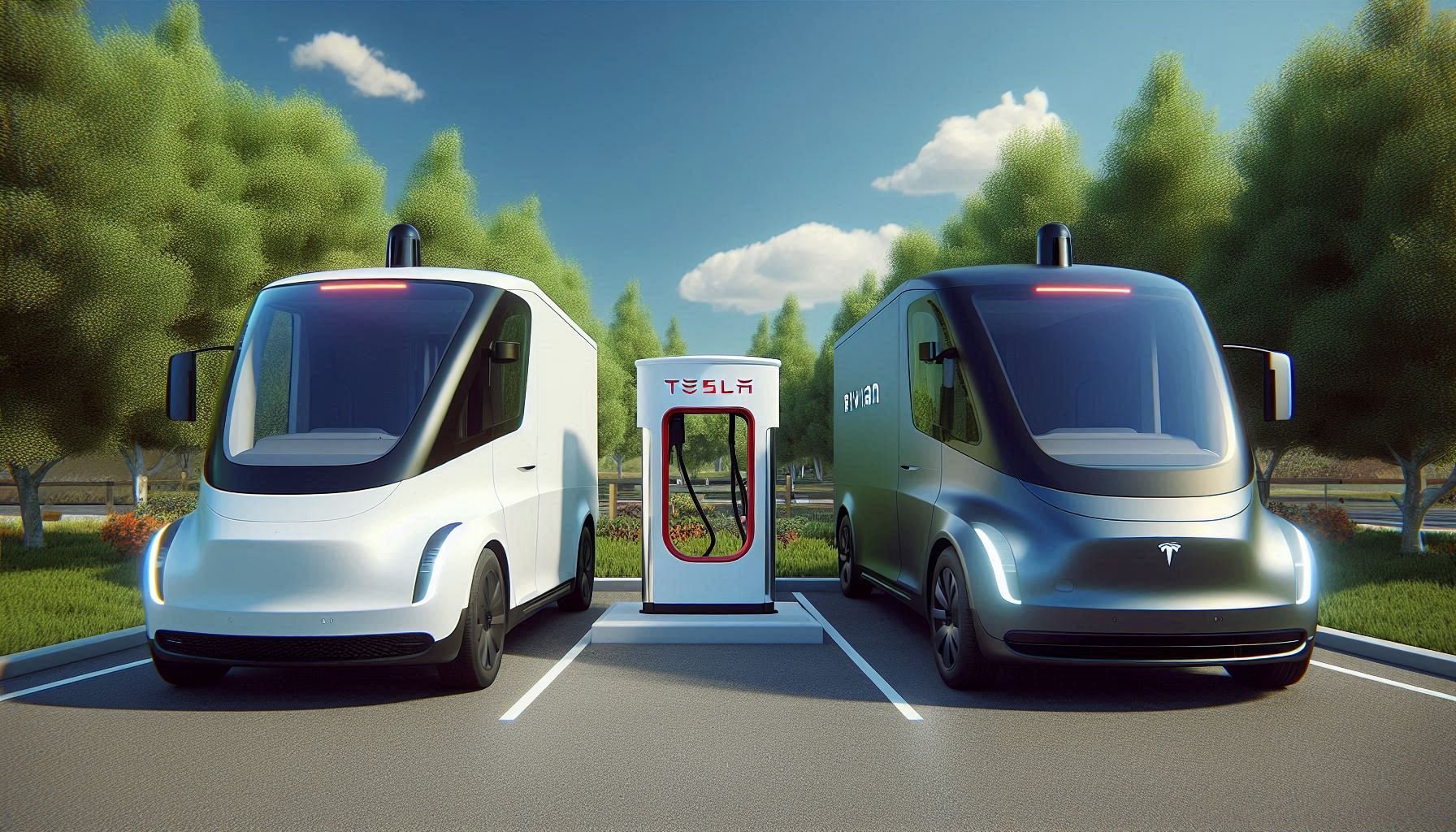The race for autonomous vehicles is heating up, with Rivian and Tesla emerging as two of the most talked-about companies in the electric vehicle (EV) market. Both companies are pushing the boundaries of self-driving technology, but they approach it differently. This article will delve into the key differences and unique strengths of each, helping you understand what sets Rivian and Tesla apart when it comes to autonomous driving.
Overview of Rivian and Tesla’s Self-Driving Tech
Rivian and Tesla have each developed unique self-driving systems, branded differently but with similar goals. Here’s a look at each company’s approach:
Tesla’s Full Self-Driving (FSD)
Tesla’s Full Self-Driving (FSD) is an advanced system that uses a combination of AI, cameras, and sensors to allow its vehicles to navigate without driver intervention in certain situations. Key elements of Tesla’s FSD include:
- Autopilot and Enhanced Autopilot: Basic Autopilot provides features like automatic steering, braking, and acceleration, while Enhanced Autopilot includes more advanced functions like lane changes and Summon mode.
- FSD Package: The FSD package offers features such as Navigate on Autopilot, which can guide the car from highway on-ramps to off-ramps.
- Neural Network: Tesla’s powerful AI learns from real-world driving data collected from millions of Tesla vehicles, which allows it to improve over time.
Rivian’s Driver+ System
Rivian’s Driver+ is the company’s suite of hands-free driving features. While not yet as advanced as Tesla’s FSD, Driver+ has some impressive capabilities:
- Hands-Free Driving Assistance: Driver+ offers features like automatic lane centering, speed adjustment, and following distance control.
- Adaptive Cruise Control: The system can adjust speed based on traffic, helping to ensure smoother rides.
- Over-the-Air Updates: Similar to Tesla, Rivian can update its software remotely, meaning its self-driving features will improve over time.
Comparing Key Self-Driving Features
Let’s dive deeper into how these systems compare on core features like lane-keeping, highway driving, and overall user experience.
1. Highway Navigation
- Tesla: Tesla’s Navigate on Autopilot feature allows the car to handle entire highway stretches, even merging lanes and taking exits without driver input.
- Rivian: Rivian’s Driver+ is designed primarily for hands-free driving on highways but lacks Tesla’s exit and lane-change automation.
Winner: Tesla, due to more comprehensive highway autonomy.
2. Urban and City Driving
- Tesla: Tesla’s FSD package allows vehicles to navigate city streets, stop at traffic lights, and make turns at intersections—still with supervision required.
- Rivian: Currently, Rivian’s Driver+ is limited to highway scenarios and hasn’t fully entered urban settings.
Winner: Tesla, with more versatility in various driving conditions.
3. Safety and Redundancy
- Tesla: Tesla’s system relies primarily on cameras, with minimal radar, and it doesn’t currently use LiDAR technology. Tesla’s AI system is robust and continuously updated, but it has been criticized for occasional incidents due to its reliance on vision alone.
- Rivian: Rivian combines cameras, radar, and ultrasonic sensors, offering a well-rounded approach to road sensing, although it also lacks LiDAR. Rivian’s emphasis on radar may enhance its reliability in poor visibility.
Winner: Both Tesla and Rivian excel here, with Rivian having an edge in challenging weather due to radar emphasis.
4. Over-the-Air Updates
Both Tesla and Rivian offer over-the-air (OTA) updates, allowing for continuous improvements and feature enhancements. OTA capabilities mean that both brands can roll out fixes, new features, and even major upgrades without a trip to the service center.
Winner: Tie, as both Tesla and Rivian keep their software fresh with OTA updates.
5. User Interface and Controls
- Tesla: Tesla’s minimalist, touchscreen-dominated interface centralizes all controls, which some drivers find intuitive, while others find it distracting.
- Rivian: Rivian’s interface is also sleek but includes a few physical buttons for essential functions. The UI is designed to be user-friendly and integrates Amazon’s Alexa, offering a familiar voice assistant.
Winner: Rivian, due to a balance of touchscreen and physical controls that some users prefer.
Tesla’s Edge: Neural Network and Data Collection
Tesla’s AI has a significant advantage due to its fleet data. Every Tesla on the road feeds back information to its neural network, improving its overall understanding of real-world driving scenarios. This deep learning enables Tesla to update its FSD software based on actual driving conditions and driver inputs.
Rivian’s Advantage: Outdoor and Adventure Focus
Rivian has positioned itself as an adventure brand, targeting outdoor enthusiasts. Its self-driving features are designed to complement off-road experiences, though Rivian’s autonomous system is still primarily for paved roads. The rugged design of Rivian’s vehicles makes them suitable for a variety of terrains, giving them an edge in flexibility, even if self-driving is limited.
Limitations of Both Systems
Neither Tesla’s nor Rivian’s self-driving systems are fully autonomous yet. Both require drivers to be attentive and ready to take control at any moment, especially in complex situations. Tesla’s FSD, while advanced, is still classified as “Level 2” autonomy, and Rivian’s Driver+ is also a Level 2 system, meaning full hands-free driving is not yet available.
Pricing Comparison
- Tesla: Tesla’s FSD is an optional add-on with a significant cost, and it can be purchased outright or as a subscription.
- Rivian: Rivian includes Driver+ as a standard feature on all vehicles, making it accessible without additional charges. This can make Rivian a more appealing option for those looking to explore self-driving tech without a major upfront investment.
Winner: Rivian, due to lower costs associated with its self-driving features.
Future of Rivian vs. Tesla Self-Driving
- Tesla: Tesla’s roadmap includes eventually achieving full autonomy. With its strong AI development team and extensive data resources, Tesla aims to reach “Level 5” autonomy in the future, where no driver intervention is required.
- Rivian: Rivian’s focus may remain on enhancing safety and adventure-based driving experiences rather than pursuing full autonomy. Rivian’s continual software improvements should enhance its Driver+ features over time, even if it doesn’t push for full automation as aggressively as Tesla.
Conclusion: Which Is Right for You?
When it comes to self-driving capabilities, Tesla currently holds the advantage in both technology and development. Its FSD system is more advanced and better suited to navigating various driving scenarios, making it a top choice for tech-savvy users who want to experience cutting-edge autonomy.
Rivian, however, offers a robust set of features for those interested in hands-free driving on highways and other straightforward scenarios. For outdoor enthusiasts and those looking for a balanced experience between autonomous driving and rugged design, Rivian could be the ideal choice.
Both brands are pioneering self-driving advancements, but their approaches and strengths differ. Ultimately, your choice will depend on your priorities—whether you value Tesla’s AI-driven autonomy and extensive data network or Rivian’s balanced, adventure-ready design with accessible self-driving features.


